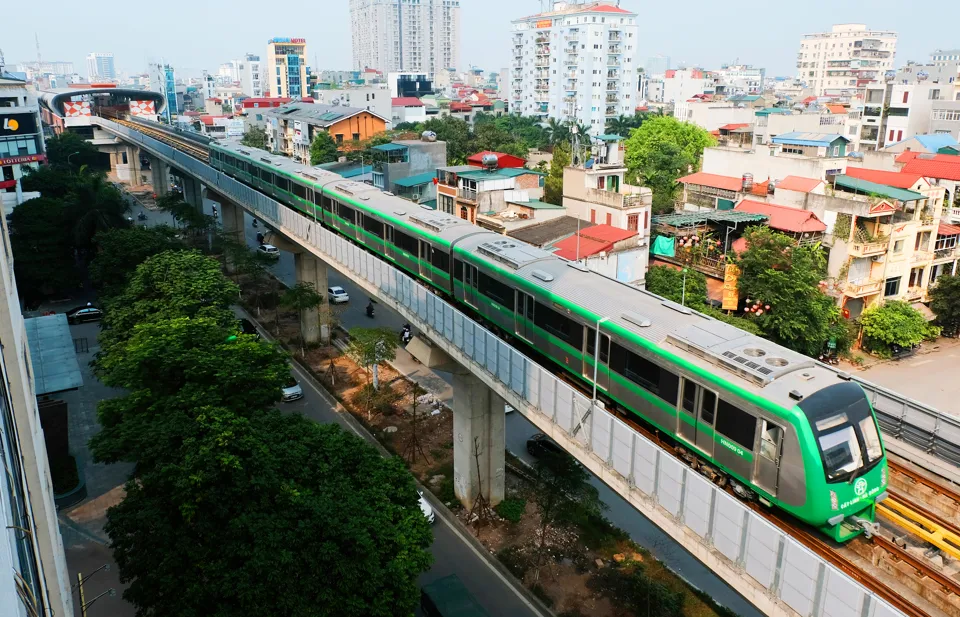Hanoi pushes vision of green transport system
Transitioning away from motor vehicles to green transportation is not only a viable option for the present but also for the future of the capital.
Hanoi's unwavering commitment to gradually realize its vision of a green transportation system is evident in the ongoing presence of electric trains, electric buses, compressed natural gas (CNG)-powered buses, electric taxis, bicycles, and public electric bicycles.
| The Cat Linh - Ha Dong urban railway. Photo: Cong Hung/The Hanoi Times |
Preliminary results
Green transportation involves the use of transportation methods that minimize the emission of CO2 and other harmful pollutants into the environment.
These include human-powered vehicles, renewable energy sources, electricity, and compressed natural gas.
Hanoi, despite struggling with escalating traffic congestion and air pollution due to a surge in private vehicles, is making strides in adopting green transportation. The majority of residents still rely heavily on private vehicles, particularly motorcycles, while walking, cycling, or using public transportation are somewhat unpopular.
In this context, the transition from motorized vehicles to green transportation is not only a viable option for the present but also for the future of the capital. Globally, many countries have made significant strides in developing green transportation solutions. The Netherlands, for instance, is known as a cycling haven, while Japan and South Korea have introduced affordable and convenient bike-sharing models in numerous cities. In many developed countries, there is an ongoing shift from gasoline-powered cars to electric vehicles and solar-powered options.
To keep pace with this global trend, Hanoi has dedicated substantial efforts over the past few years and has begun to see significant results. These accomplishments include the launch of the Cat Linh - Ha Dong urban railway, the introduction of 10 electric bus lines, and the operation of four bus routes with CNG-powered vehicles.
The Transport Corporation of Hanoi has also signed compressed air supply agreements with a Russian company, laying the groundwork for additional "clean" bus routes.
Furthermore, Hanoi has licensed a number of electric taxis and has introduced bicycles and electric bike-sharing in selected urban districts. In 2024, the Nhon - Cau Giay section of railway line No.3 is expected to be put into operation, further increasing the share of green public transportation.
Despite facing numerous difficulties and challenges, Hanoi is undeniably moving in the right direction in transitioning to sustainable public transportation methods. The adoption of green vehicles in public transport not only actively contributes to environmental protection but also appeals to passengers, gradually shifting their preference from private cars to trains and buses.
"Electric trains offer the advantage of high speed, whereas buses and electric taxis are somewhat affected by traffic congestion. However, these transportation modes share the common attribute of being clean, orderly, and providing a more comfortable experience compared to gasoline or diesel-powered trains. Consequently, they are gaining popularity among passengers. I personally switched to using electric buses when they became available," Duong Hong Minh from Hoang Liet ward, Hoang Mai district, shared his perspective.
Phan Truong Thanh, an urban expert, has analyzed that the integration of electric buses, taxis, and public electric bicycles with urban railways will significantly enhance connectivity and modernize Hanoi's transportation system.
These various forms of clean-fuel public transportation not only complement each other in terms of connectivity and mobility but also contribute to the establishment of a comprehensive green transportation ecosystem.
More support needed
Despite initial successes, there are concerns that Hanoi may not have the necessary conditions to develop a green transportation model, particularly due to a lack of investment capital and technical infrastructure for clean buses and trams.
Thanh, however, said there are challenges everywhere. “The biggest challenge is not the lack of funds or infrastructure but the need for self-discipline and collective action in the interest of the community,” Thanh noted.
The ingrained habit of using motorcycles and private cars is deeply ingrained among many Hanoians. Introducing restrictions on private vehicles and promoting walking, cycling, and public transportation have met with resistance and differing opinions within the city government.
To create a modern, civilized, and sustainable Hanoi with green transportation, the primary resource required is well-crafted policies. Policies should address issues such as restrictions on private vehicles, investment in public transportation, the development of clean fuel vehicles, and the promotion of bicycling and walking. These policies need to be clear, specific, and tailored to the city's needs, he continued.
The expert suggested that the city should provide more incentives to encourage public transportation businesses to adopt natural gas and electric buses. Simultaneously, measures should be taken to restrict the use of private vehicles and encourage people to use public transportation to ensure economic efficiency and reduce congestion on the roads.
Moreover, both the government and the city administration should develop policies to attract private investment in urban mass rapid transit (UMRT) and other green transportation modes.
Echoing Thanh, Le Trung Hieu, Deputy Head of the Metropolitan Railway Management Board, suggested that public agencies and businesses in Hanoi must set an example by reducing the use of gasoline and oil-powered motorcycles and cars in favor of bicycles, clean buses, trams, and electric vehicles.
“This shift can be a breakthrough, integrating the policy of restricting personal vehicles into the fabric of urban life in Hanoi,” Hieu said.
He added that currently, thousands of officials, employees, civil servants, and public workers in Hanoi, continue to commute by motorcycles and private cars every day, even for short distances. If this group can shift to walking, cycling, trams, and buses, it will significantly ease traffic congestion, reduce environmental pollution, and promote the green transportation movement within the city center.
“Green transportation represents a comprehensive solution for Hanoi's current and future urban areas. The city government and its residents must work together and unite to drive the adoption of green transportation methods, minimize the use of private vehicles, and create a more modern, civilized, and livable capital,” he emphasized.












